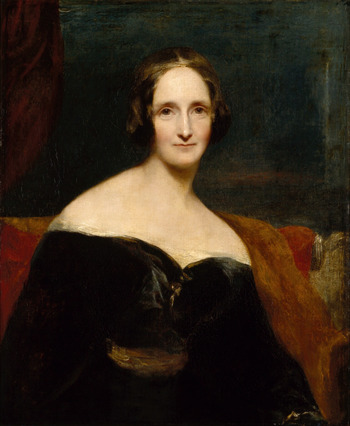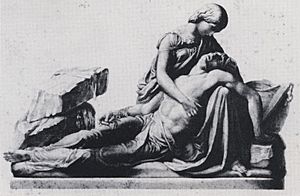Mary Shelley facts for kids
Quick facts for kids
Mary Shelley
|
|
|---|---|

Richard Rothwell's portrait of Shelley was shown at the Royal Academy in 1840, accompanied by lines from Percy Shelley's poem The Revolt of Islam calling her a "child of love and light".
|
|
| Born | Mary Wollstonecraft Godwin 30 August 1797 London, England |
| Died | 1 February 1851 (aged 53) London, England |
| Occupation | Writer |
| Notable works | Frankenstein (1818), among others |
| Spouse | |
| Children | 4, including Percy Florence |
| Parents | |
Mary Wollstonecraft Shelley (born Godwin; August 30, 1797 – February 1, 1851) was an English writer. She is best known for her famous novel Frankenstein; or, The Modern Prometheus, published in 1818. This book is often seen as one of the first science fiction stories ever written. Mary Shelley also worked to publish and share the writings of her husband, Percy Bysshe Shelley, who was a well-known Romantic poet and thinker.
Contents
Mary Shelley's Early Life
Mary Shelley's father was William Godwin, a writer and thinker interested in how societies should be run. Her mother was Mary Wollstonecraft, a philosopher who strongly supported women's rights. Sadly, Mary's mother passed away just two weeks after Mary was born.
Mary's father raised her and her older half-sister, Fanny Imlay. He gave Mary a rich but informal education at home. He encouraged her to think freely and follow his ideas about how people should live together. When Mary was four, her father married a neighbor named Mary Jane Clairmont. Mary and her stepmother often had a difficult relationship.
Family and Challenges
In 1814, Mary fell in love with Percy Bysshe Shelley, a young poet who admired her father's ideas. They traveled through Europe with Mary's stepsister, Claire Clairmont. When they returned to England, Mary was expecting Percy's child.
Over the next two years, Mary and Percy faced many difficulties. They struggled with money and the loss of their first child, who was born too early. They married in late 1816, after Percy Shelley's first wife passed away.
In 1818, the Shelleys moved to Italy. There, they faced more sadness as their second and third children died. However, Mary later gave birth to her last child, Percy Florence Shelley, who was their only child to survive into adulthood. In 1822, her husband Percy drowned when his boat sank during a storm. A year later, Mary Shelley returned to England. From then on, she focused on raising her son and building her career as a writer. In her last ten years, she suffered from an illness, likely a brain tumor, which led to her death at age 53.
Writing Frankenstein
In the summer of 1816, Mary and Percy Shelley, along with Mary's stepsister, spent time with Lord Byron and John William Polidori near Geneva, Switzerland. During this time, Mary had the idea for her most famous novel, Frankenstein.
Frankenstein is still widely read today. It has inspired many plays and movies. For a long time, Mary Shelley was mainly known for this one book and for helping to publish her husband's works.
Mary Shelley's Other Books
More recently, people have become very interested in Mary Shelley's other writings. Scholars now study her other novels, which include historical stories like Valperga (1823) and Perkin Warbeck (1830). She also wrote The Last Man (1826), a story about the end of the world. Her final two novels were Lodore (1835) and Falkner (1837).
Studies of her less famous works, like her travel book Rambles in Germany and Italy (1844), show that Mary Shelley remained a strong believer in social change throughout her life. Her writings often suggested that working together and showing kindness, especially among women in families, could help improve society. This idea was different from the focus on individual freedom often seen in the Romantic movement of her time and in her father's political ideas.
How Was Mary Shelley Seen?
During her lifetime, Mary Shelley was respected as a writer. However, critics sometimes missed the deeper political messages in her work. After her death, she was mostly remembered as Percy Bysshe Shelley's wife and as the author of Frankenstein. Some scholars even suggested that her importance came mainly from being connected to her famous husband. It wasn't until 1989 that a full book-length study of her life as a writer was published.
Mary Shelley's son and daughter-in-law later tried to make her seem more traditional and less rebellious. They did this by carefully editing her personal papers. Mary herself also avoided public arguments in her later years, which added to this impression. Some of Percy Shelley's friends also tried to make Mary Shelley seem less radical. One friend even questioned her intelligence and whether she truly wrote Frankenstein.
From the first play based on Frankenstein in 1823 to many movies, like the 1931 film Frankenstein and Mary Shelley's Frankenstein in 1994, many people first learn about Mary Shelley's work through these adaptations. For much of the 19th century, Mary Shelley was seen as an author who wrote only one important book. Most of her other works were not printed for a long time.
However, in recent years, almost all of her writings have been republished. This has led to a new appreciation for her work. Her love for reading and studying, shown in her journals and letters, is now better understood. Scholars now see Mary Shelley as an important figure of the Romantic era, valued for her writing and her strong voice as a woman and a supporter of liberal ideas.
Selected Works
- History of a Six Weeks' Tour (1817)
- Frankenstein; or, The Modern Prometheus (1818)
- Mathilda (1819)
- Valperga; or, The Life and Adventures of Castruccio, Prince of Lucca (1823)
- Posthumous Poems of Percy Bysshe Shelley (1824)
- The Last Man (1826)
- The Fortunes of Perkin Warbeck (1830)
- Lodore (1835)
- Falkner (1837)
- The Poetical Works of Percy Bysshe Shelley (1839)
- Contributions to Lives of the Most Eminent Literary and Scientific Men (1835–39), part of Lardner's Cabinet Cyclopaedia
- Rambles in Germany and Italy in 1840, 1842, and 1843 (1844)
Many of Mary Shelley's original papers are kept in important libraries. These include the Bodleian Library, the New York Public Library, the Huntington Library, and the British Library.
See also
 In Spanish: Mary Shelley para niños
In Spanish: Mary Shelley para niños
- Mary Shelley (2017 film)
- Godwin–Shelley family tree
- Map of 1814 and 1816 European journeys
- Map of 1840s European journeys


